Scottish Marine and Freshwater Science Volume 3 Number 3: Clyde Ecosystem Review
A review of previously published information and knowledge concerning the Firth of Clyde ecosystem and suggestions for further studies in the Clyde required in order to support sustainable use of this active Scottish marine ecosystem
5. HUMAN IMPACTS (OTHER THAN FISHING)
In UK waters most problems associated with human impacts other than fishing are local in nature particularly in industrialised estuaries and coasts such as the Firth of Clyde. The major component affecting the Clyde is associated with the substantial historical and current inputs of hazardous substances from industrial and domestic waste. The region is the most industrialised and urbanised area of Scotland and is arguably Scotland's most heavily contaminated water body (Webster, et al. 2005). The marine environment is described as the ultimate sink for many hazardous substances that result from the waste produced by industry. Substances identified as a particular cause for concern in the Clyde include cadmium, lead, mercury, pesticides and persistent organic pollutants ( POP's). Although the use of some of these substances has been banned they still continue to be present in the marine environment as a result of historical use (Baxter et al., 2011). Information on sewage and industrial discharges into the Clyde and their effects on the environment have been well-documented as part of the Annual Reports produced by the former Clyde River Purification Board which is now incorporated into the Scottish Environment Protection Agency ( SEPA).
The most concentrated source of contaminants into the Clyde is at Garroch Head, south of the Isle of Bute and at Cloch Point ( Figure 5.1). Sewage sludge has been disposed of at Garroch Head since 1904 until the site was closed under the EC Urban Waste Water Treatment Directive 91/271/ EEC 1998. By the 1990's more than 1,500,000 tonnes of sewage sludge was being disposed of annually at Garroch Head. The site had been moved 4 km south in 1974 after the introduction of the Dumping at Sea Act where dumping was confined to a circular area one nautical mile in diameter. Levels at the old site were particularly persistent as the effects of the new site, which experienced higher rates of input and more precise dumping, had amplified the effects of sludge disposal at the former site (Rodger et al., 1992). The problem was further exacerbated due to the hydrology of the area, where currents are relatively slow (<10 cm s -1) and does not allow enough dispersion of pollutants; this causes localised problems to occur (Mojtahid et al., 2008). Monitoring has been undertaken at Garroch Head following the cessation of dumping in 1998, to assess recovery. However, the disposal of dredged material at sea continues in the Clyde at Cloch Point and is authorised under part II of the Food and Environment Protection Act 1985 ( FEPA). Other sources of contaminants into the Clyde include run-off from urban areas, oil spills and atmospheric deposition which diffuses into the marine environment.
The pollution into the Clyde constitutes a major source of persistent organic pollutants ( POPs) such as polychlorinated biphenyls ( PCBs) and polycyclic aromatic hydrocarbons ( PAHs). In more recent times increased regulation has reduced contaminant inputs. However, due to the persistent nature of many hazardous substances, high concentrations can still be found in marine sediments as a result of historical inputs. The extent to which these hydrophobic compounds are accumulated is dependent on sediment type. Sediments with high organic carbon content and a small particle size, such as those of the inner Clyde, have a greater potential to accumulate hydrophobic contaminants than coarser sediments (Webster et al., in press). The immediate effect of the accumulation of such contaminants has been to cause organic enrichment of the sediment which in turn causes changes in the benthic infauna and a decrease in biodiversity (Rodger, 1992, Kelly and Campbell, 1995).
Figure 5.1 Map showing the dump sites at Garroch Head, pre- and post- 1974.
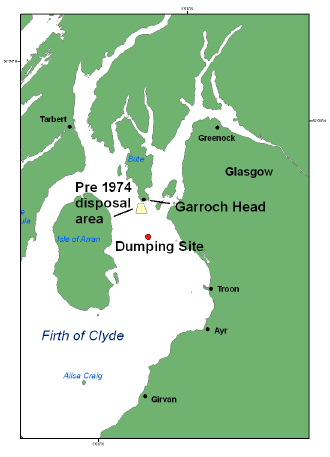
PCBs are synthetic substances which have been produced in Europe since 1929 until the mid 1980s and used in hydraulic fluids, insulators, sealants and grouting ( OSPAR, 2010). PCBs are toxic, persistent and lipophilic and are bioaccumulated by fish especially in the liver due to its high lipid content. They can adversely affect reproduction, and may affect immune systems which can result in disease epidemics. Organisms at the higher levels of the food web, especially seabirds and marine mammals, can be particularly affected ( OSPAR, 2010).
PAHs are widespread chemical pollutants that are introduced into the marine environment from many different sources. They are natural components of coal and oil and are mainly produced by the incomplete combustion of carbon-containing fuels; as a result they are one of the most widespread organic pollutants ( OSPAR, 2010). PAHs are toxic, persistent and are known to be both mutagenic and carcinogenic. Due to their low aqueous solubility and hydrophobic nature, PAHs tend to associate with particulate matter and can be bio-accumulated especially by shellfish.
Inputs of trace metals such as cadmium and mercury result from discharges of sewage and from the fish farm industry. Most trace organic compounds are insoluble in water and are below detection concentration levels. However, Lindane (γ-hexachlorocyclohexane ( HCH)) which is used in insecticides is relatively soluble in water and present in measurable concentrations. The Clyde Sea currently has the highest inputs of Lindane (y- HCH) compared to the rest of Scotland (Baxter et al., 2011).
The Water Framework Directive ( WFD) establishes a legal framework for the protection, improvement and sustainable use of surface waters, transitional waters, coastal waters and groundwater across Europe. In Scotland, this work is undertaken primarily by SEPA in conjunction with the Scottish Government. For aspects of coastal waters not covered by the Water Framework Directive, the Marine Strategy Framework Directive ( MSFD) sets out environment protection and improvement measures for marine waters.
Monitoring of hazardous substances in the Scottish marine environment is required in order for Scotland to meet international obligations to OSPAR and under EU legislation. Hazardous substances highlighted to be of concern such as those already mentioned are monitored routinely in Scotland by either Marine Scotland or SEPA. The monitoring programmes cover the different marine components measuring contaminants in waters, sediments and biota to determine the long term fate of these materials. Those that are soluble remain in solution where insoluble contaminants are more likely to be incorporated in the sediments or bio-accumulated in animal tissue.
To assess contaminant concentrations in the Firth of Clyde in relation to the Garroch head dump site, fish have been sampled annually since 1992 and sediment samples taken since 1999 (Webster et al., 2005). Assessment criteria have been developed for metals and organic contaminants ( PAHs and PCBs) in both sediment and biota on an international basis through the auspices of OSPAR, ICES and the EU. The main programme for monitoring the status of contaminants in UK waters is the 'Clean Seas Environmental Monitoring Programme' ( CSEMP). CSEMP measures the concentrations of specific chemicals which are persistent, toxic and have the ability to accumulate in food chains, at almost 500 sites around the UK ( UKMASS, 2010). Assessment criteria for these sites have been developed based on concentration thresholds (in sediments and biota) above which these contaminants could be toxic to both marine organisms and to human consumers of seafood.
Blue, Status is acceptable. Concentrations are near background for naturally occurring substances ( e.g. PAHs) or close to zero for man-made substances ( e.g. PCBs).
Green, Status is acceptable. Concentrations of contaminants are at levels where it can be assumed that little or no risks are posed to the environment and its living resources at the population or community level.
Red, Status is unacceptable. Concentrations of contaminants are at levels where there is an unacceptable risk of chronic effects occurring in marine species, including the most sensitive species.
OSPAR international standards for concentrations of contaminants are as follows; contaminant concentrations are considered to be low if they are below the Background Assessment Concentration ( BAC), slightly elevated if above the BAC but below the Environmental Assessment Criteria ( EAC) and of concern if above the EAC.
The general trend in Scottish waters for metal contaminants is that the input in disposed waste is declining and these downward trends for mercury, cadmium and lindane are reported in Charting Progress 2 and Scotland's Marine Atlas (see Figure 4.2). In a recent study by Webster et al. (in press) PAH, PCB and PBDE concentrations were found to be significantly higher in sediment and fish liver from the Clyde compared to all other sea areas around Scotland. The PAH data from this study showed that all PAHs in all sea areas were at acceptable concentrations (green) except for the Clyde.
The Clyde Sea area is sampled at seven different stratum from north to south; 1 Firth of Clyde Inner Dunnon; 2 Firth of Clyde Inner Cumbraes; 3 Largs Chanel; 4 Firth Clyde Middle Offshore; 5 Irvine Bay; 6 Firth of Clyde Outer Offshore; 7 South Arran ( Figure 5.3). Although PAH concentrations in the sediment were found to be above assessment criteria in the areas of the inner Clyde, a downward trend was detected. PAH concentrations also showed a significant gradient going from north to south stratum with the lowest concentrations being in the strata closest to the open sea (Webster et al., in press) see Figure 5.4.
Figure 5.2 Source, Scotland's Marine Atlas (2011) (Baxter et al., 2011).
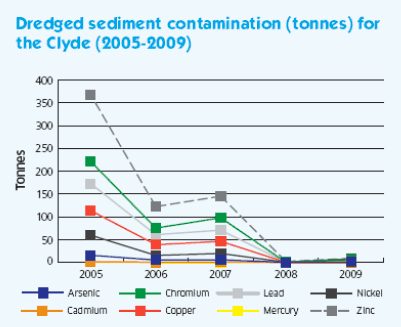
Figure 5.3 Location of sampling sites for each stratum in the Clyde
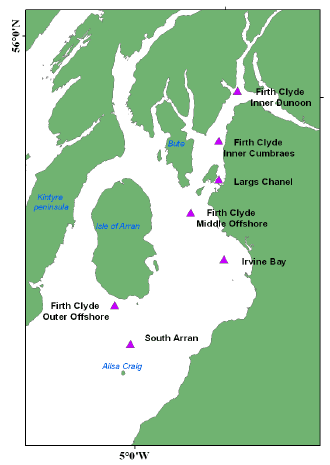
Figure 5.4 Interval plot of time-averaged individual parent PAH concentrations in sediment (μg kg -1 dry weight normalised to 2.5% TOC) for the strata in the Clyde. The error bars are the 95% confidence limits. Sites are highlighted 'blue', 'green' or 'red' on the basis of the concentration relative to assessment criteria. (Source, Webster et al., in press)
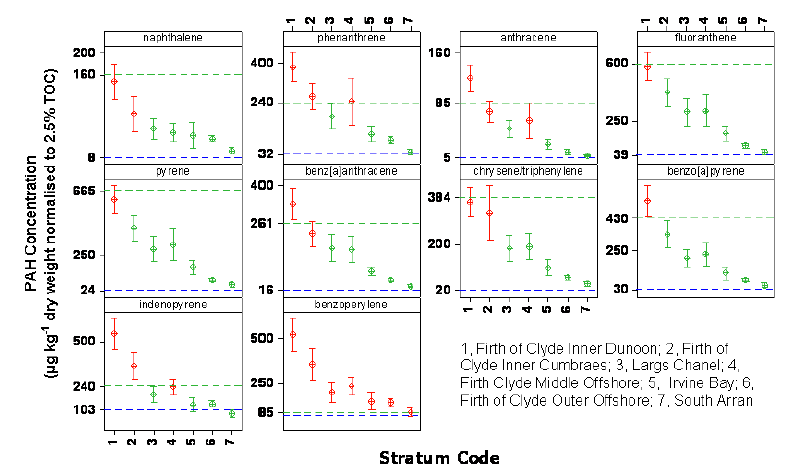
The accumulation of mercury in fish flesh has been investigated in relation to the disposal sites in the Clyde (Clark, 1989). Mercury is of particular interest as it can be transmitted through the food chain and can be potentially passed on to humans. However, fish from the Clyde have not accumulated mercury above background concentrations (Roger, 1992).
The most toxic PCB ( CB118) is present above the EAC in mussels and one sediment site in the Firth of Clyde and it is of concern that adverse biological effects may be seen in marine biota in the area (see Figure 5.5).
Figure 5.5 A - CB118 in sediments normalised to 2.5% TOC. B - CB118 in Biota. . C- Pyrene in sediments normalised to 2.5% TOC. D - Pyrene in Biota. Source, Scotland's Marine Atlas (Baxter et al., 2011)
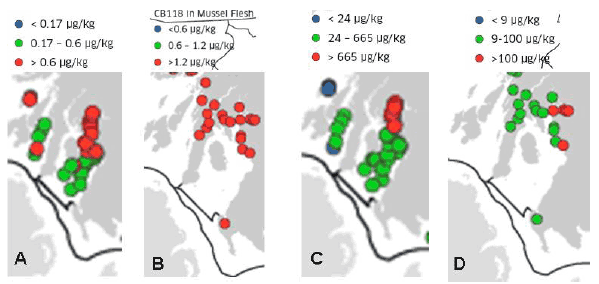
In order to determine the biological effects of hazardous substances bioassays of two species, the crustacean Corophium volutator and the polychaete worm Arenicola marina, are used (Baxter et al., 2011). Toxicity is determined by the number of test organisms which survive in the test sediments compared to uncontaminated control sediments. The sediments from two sites in the inner Firth of Clyde were found to contain the highest level of contaminants from the coastal areas around Scotland and the bioassays indicated that adverse effects are possible at these sites (Baxter et al., 2011). However analysis of the sediments does not show any adverse impacts at present.
The overall status of the sea areas around Scotland assessed for persistent organic pollutants ( POPs) are considered to be acceptable as concentrations were below those likely to result in chronic effects except for in the Clyde Sea area. However, a downward trend in PAH in sediments in the Clyde has been detected and in comparison to other seas around the wider UK the environmental status of the Clyde has few problems (see Figure 5.6).
Figure 5.6 Pollution status of the seas around Scotland Source, The State of UK Seas, Charting Progress 2, ( UKMASS, 2010).
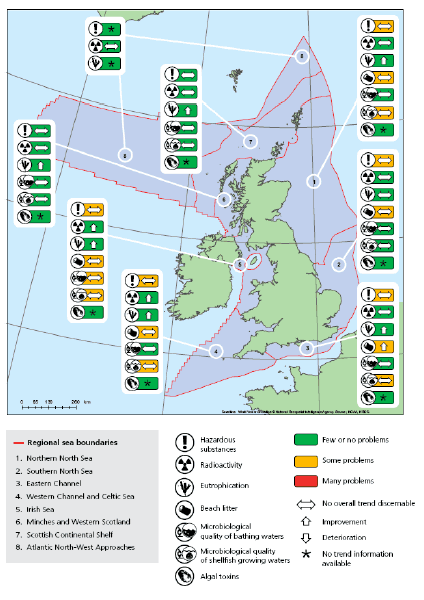
Marine and beach litter is a significant issue in the Firth of Clyde and around Scotland. Marine litter has been an ongoing problem for many years and originates from many different sources such as recreation and tourism, fishing debris, sewage related debris and shipping waste (Somerville et al., 2006). In addition, the litter in Scottish seas may be derived locally or have travelled thousands of miles from well outside Scotland's influence. Some sea lochs around Scotland act as a natural collecting funnel (known as litter sinks) such as at the head of Loch Long at Arrochar in the Clyde Sea, which collects large accumulations of litter on the beach even though the population of the surrounding area is quite small.
It has been estimated that approximately 80% of marine litter originates from land-based sources and that up to 90% of the waste consists of plastics which can persist for a significant amount of time (Davison, 1996). Litter in the marine environment gives rise to a range of adverse ecological impacts, including; entanglement, smothering, ingestion, disturbance of habitat, transport of invasive species and poisoning by the breakdown of products. The major impacts of marine litter on fishery interests results from damage to nets and fouling of fishing grounds (MaLITT, 2002). Fishing itself remains one of the worst sources of marine litter. The most significant impact of litter from fisheries is ghost fishing where lost fishing gear, particularly from creel fisheries, continues to capture target and non-target species. However, in the Clyde the effects of this have been shown to be minimal with most species able to escape from creels over time (Adey, 2007).
In general there is little known about the extent and composition of marine litter around the Firth of Clyde. This is mainly due to the lack of a systematic monitoring programme being in place in Scotland and no agency that has overall responsibility for tackling marine litter (Donnelly et al., 2010). However, Marine Scotland is currently leading the development of a Scottish marine litter strategy.
Historically the ports of the Firth of Clyde have played a vital role in the prosperity of Scotland. The Clyde is a major international shipping location, which has several major ports, busy shipping lanes and a BP oil terminal in Loch Long. The major ports of the Clyde are Glasgow, Greenock, Hunterston, Ardrossan and Stranraer. The contribution of ports and water transportation to business and Scotland's economy is quite significant. About 95% of UK imports and exports are transported by sea. Clydeport itself is the third largest port in Scotland and the eleventh largest in the UK by volume of traffic. Figure 5.7 illustrates the shipping infrastructure in the Firth of Clyde.
Figure 5.7 Shipping and transport infrastructure in the Firth of Clyde (Source, SSMEI Clyde Pilot, Donnelly et al. 2010).
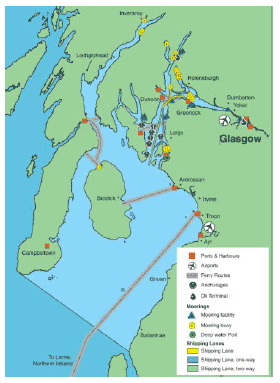
Aquaculture has been the fastest growing food production sector in the world and currently Scotland is the largest aquaculture producer in the European Union (Hall-Spencer et al., 2006). Scotland's fjords provide sheltered cool waters and high water exchange well suited for the farming of salmon (Hall-Spencer et al. 2006). The industry in Scotland is dominated by salmon production but also has significant rainbow trout and mussel production. Scotland Highland and Island salmon farming has grown dramatically and is an increasingly important industry helping to underpin economic growth in rural coastal communities (Baxter et al., 2011). The Firth of Clyde has in recent years, like many other areas on the West Coast of Scotland, become an important focus of aquaculture processes. There are a number of salmon farms to the North of the region, such as in Loch Fyne and Loch Striven, and some further south at Arran. Figure 5.8 shows the trends in salmon and shellfish (particularly mussel) aquaculture for Scotland since 2005.
There are growing concerns over the environmental effects of the aquaculture industry (Fernandes et al. 2001). Aquaculture generates considerable amounts of effluent from nutrients, waste feed, faeces and from the by-products of pesticides. In shallow waters with weak under currents, waste products from marine cages settle on the bottom accumulating and smothering organisms on the sea floor. This can result in alterations to the infaunal community structure and lowered species diversity. In deeper waters and where there are stronger currents effluents released should be dispersed over a larger area. Fish farms located over maerl beds; although in a tidally strong location can get particulates trapped within the complex matrix of the thalli. Marine fish farming can thus have harmful effects on the surrounding environment. In semi-enclosed sea lochs, cage aquaculture of Atlantic salmon is the most common source of organic enrichment. The area of sea floor impacted by fish faeces and uneaten food will depend on the size and tonnage of the farm, on water depth, and on the local hydrodynamic conditions (Hughes, 1998).
Figure 5.8 Trends in production and turnover from 2005-2009 for a) Atlantic salmon b) Mussel and other shellfish. Source, Scotland's Marine Atlas, 2011.
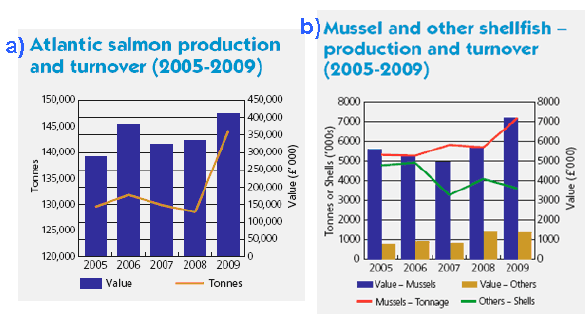
5.6 Scotland's Marine Atlas - Overall Assessment
The following is adapted from Scotland's Marine Atlas, Regional assessments, Solway, North Channel and Clyde (Baxter et al., 2011)
5.6.1 Activities and Pressures
The Clyde hosts a wide range of human activities and consequently is subject to a number of pressures. Aquaculture, particularly salmon and shellfish production, takes place in a number of sea lochs and there is widespread fishing, mainly for Nephrops and scallops.
There are significant ports, shipping and ferry activities with 20% of Scottish cargo volume passing through the Clyde ports. The Clyde is one of the busiest areas for ferry traffic with key links to various islands and peninsulas, as well as Northern Ireland, accounting for ~60% of overall Scottish passenger traffic.
Scotland's only Naval base is on the Clyde.
The Clyde is popular for recreational sailing, supporting ~40% of Scottish boat berths. There are also popular bathing beaches on the Ayrshire coast.
The Clyde Estuary and Ayrshire coast are relatively urbanised and industrialised compared with other parts of Scotland. This results in discharges from waste water treatment works and industrial effluents to estuary and coastal waters, as well as water abstraction, mainly for power generation.
Pressures resulting from these activities include the introduction of contaminants from industrial effluents and sewage works and dumping of dredge spoil from harbour maintenance. Fishing using trawls and dredges results in the abrasion of the seabed. There are also local effects of aquaculture on seabed ecology. Recreational boating and commercial shipping activities have probably led to the introduction of non-native species.
At the area level ( i.e. all Clyde Sea) there are few concerns in relation to hazardous substances, radioactivity, oil and chemical spills and algal toxins.
Contaminant loadings to the Clyde Estuary are lower now compared to historical discharges but a legacy of localised contaminated sediments remains. These in turn have caused elevated concentrations of contaminants in mussels in the Clyde Estuary.
Water quality in the Clyde Estuary is compromised by discharges of industrial effluent and treated sewage although effluent treatment has improved resulting in returning populations of residential and migratory fish.
The quality of bathing and shellfish waters in the Firth of Clyde is affected by inputs of bacteria from diffuse sources, which increase during periods of high rainfall.
Local accumulations of litter are observed on some beaches possibly being transported by the prevailing currents. The source is not always possible to identify.
5.6.3 Healthy and Biologically Diverse
The status of habitats within the Clyde is mixed. Intertidal habitats (rock and sediments) are deteriorating. In relation to rocky intertidal habitats this is due to invasion of non-native species, in particular wireweed. Shallow subtidal sediments are relatively degraded while shallow, subtidal rocky habitats appear to be in a better state.
In general, mobile species such as cetaceans, seals and seabirds also show a mixed picture but overall are stable at the area level.
In contrast, the reduced populations of commercial fish are a major concern.
The introduction and establishment of a number of invasive non-native species, for example, intertidal wireweed ( Sargassum muticum) and the subtidal carpet sea squirt (Didemnum vexillum), first found at Largs in 2009, is very concerning.
Many of the concerns associated with the Clyde result from historical practices and management approaches. Enhanced scientific knowledge, improved regulation and greater environmental awareness have resulted in significant reductions in inputs of contaminants and improvements in water quality.
Pressure on coastal and inshore habitats is increasing from industry such as the proposed Hunterston power station (with a possible change in cooling water requirements), aquaculture and recreational activities.
The Clyde may have a potential resource to support the generation of marine renewable energy, mainly offshore wind and tidal. Growth of the industry and development of associated infrastructure, including seabed cables, is anticipated. Further work will be required to understand the effects on seascapes and landscapes, communities, tourism and recreation.
Increasing shipping activity, possible new container facilities at Hunterston, and recreational sailing will risk the further introduction of non-native species.
Underwater noise associated with industrial and recreational activities is expected to increase. There is also the possibility of increased ferry traffic to Northern Ireland with facilities in Loch Ryan due to expand.
As Europe, the UK and Scotland prepares to implement the Marine Strategy Framework Directive, the Clyde Sea offers a potentially exciting test area, where indicators and targets describing Good Environmental Status (GES) could be developed, an integrated ecosystem monitoring scheme devised involving cross-organisational working ( i.e. Marine Scotland, SEPA, SNH) and a series of management measures implemented to take the Clyde towards GES by the target date of 2020. The Clyde offers: a pragmatic scale; a solely national management regime; a varied mix of status and pressures; diverse habitats; a representative range of stakeholders.
Contact
There is a problem
Thanks for your feedback